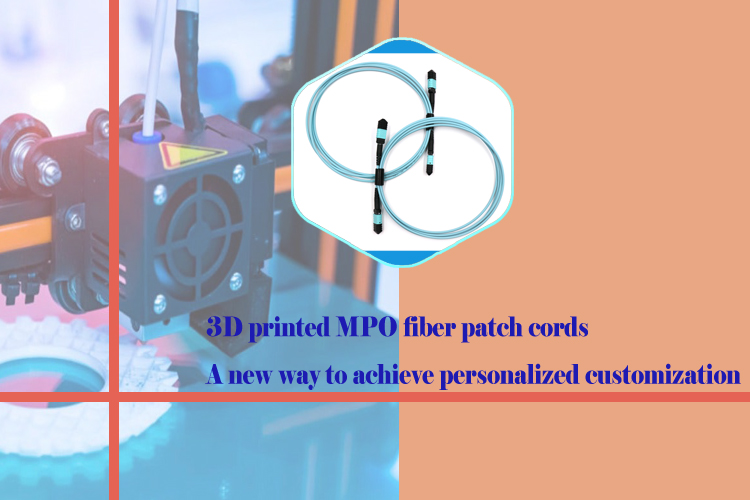3D printed MPO fiber patch cords: A new way to achieve personalized customization
MPO fiber patch cords are used to connect multiple optical fibers together in a single cable. They are often used in data centers and other high-density environments where there is a need to connect a large number of fibers in a small space.
Traditionally, MPO fiber patch cords are made by manually assembling the fibers together. This process is time-consuming and labor-intensive, and it can be difficult to achieve consistent results.
3D printing technology offers a new way to manufacture MPO fiber patch cords. With 3D printing, it is possible to create customized MPO fiber patch cords that meet the specific needs of the application. 3D printing also allows for faster production of MPO fiber patch cords, which can reduce costs.

There are a number of benefits to using 3D printing to manufacture MPO fiber patch cords. These benefits include:
.Personalization: 3D printing allows for the creation of customized MPO fiber patch cords that meet the specific needs of the application.
.Speed: 3D printing can produce MPO fiber patch cords faster than traditional manufacturing methods.
.Accuracy: 3D printing can produce MPO fiber patch cords with high accuracy.
Cost-effectiveness: 3D printing can reduce the cost of manufacturing MPO fiber patch cords.
MPO Fiber patch cords can indeed be produced using 3D printing technology. However, it is important to note that 3D printing might not be the most suitable method for manufacturing MPO Fiber patch cords due to several reasons:
.Material Selection: 3D printing typically works best with plastics, and while there are some flexible and durable materials available for 3D printing, they might not meet the stringent requirements of MPO fiber patch cords, which often require high-performance materials like ceramic or metal.
.Precision and Tolerance: MPO connectors require high precision and tight tolerances to ensure maximum optical performance and minimize signal loss. Although 3D printing technology has advanced over the years, it might be challenging to achieve the level of precision and tolerances required for MPO connectors, particularly when dealing with small fiber optic components.
.Fiber Alignment: MPO connectors have multiple parallel fibers that need to be precisely aligned. Achieving proper alignment through 3D printing could be difficult, as it may not offer the same level of accuracy compared to traditional manufacturing methods such as injection molding.
.Standard Compliance: MPO connectors follow specific industry standards, which dictate their dimensions, optical performance, and mechanical properties. Ensuring compliance with these standards might be more complicated when using 3D printing, as it may require additional testing and validation.
While 3D printing could potentially be used for prototyping or low-demand applications, it is generally not widely adopted for high-volume production of MPO Fiber patch cords due to the reasons mentioned above. Traditional manufacturing techniques like injection molding are generally preferred for producing MPO connectors, as they offer better precision, material options, and reliability.
3D printing is a promising technology for the manufacture of MPO fiber patch cords. It offers a number of benefits over traditional manufacturing methods, including personalization, speed, accuracy, and cost-effectiveness.
Conclusion
3D printing is a rapidly evolving technology that is having a major impact on a wide range of industries. In the data center market, 3D printing is being used to create customized MPO fiber patch cords that meet the specific needs of the application. This technology offers a number of benefits over traditional manufacturing methods, including personalization, speed, accuracy, and cost-effectiveness.
FAQs
Q: What is an MPO fiber patch cord?
A: An MPO fiber patch cord is a type of fiber optic cable that is used to connect multiple optical fibers together in a single cable. They are often used in data centers and other high-density environments where there is a need to connect a large number of fibers in a small space.
Q: How are MPO fiber patch cords made traditionally?
A: Traditionally, MPO fiber patch cords are made by manually assembling the fibers together. This process is time-consuming and labor-intensive, and it can be difficult to achieve consistent results.
Q: What are the benefits of using 3D printing to manufacture MPO fiber patch cords?
A: The benefits of using 3D printing to manufacture MPO fiber patch cords include:
Personalization: 3D printing allows for the creation of customized MPO fiber patch cords that meet the specific needs of the application.
Speed: 3D printing can produce MPO fiber patch cords faster than traditional manufacturing methods.
Accuracy: 3D printing can produce MPO fiber patch cords with high accuracy.
Cost-effectiveness: 3D printing can reduce the cost of manufacturing MPO fiber patch cords.
Q: What are the challenges of using 3D printing to manufacture MPO fiber patch cords?
A: The challenges of using 3D printing to manufacture MPO fiber patch cords include:
The need for professional 3D printers and materials.
The need for skilled operators to use the 3D printers.
The need for a design process that takes into account the limitations of 3D printing.
Q: What are the future trends for 3D printing of MPO fiber patch cords?
A: The future trends for 3D printing of MPO fiber patch cords include:
The development of new 3D printers and materials that are better suited for this application.
The development of new design processes that take into account the limitations of 3D printing.
The increasing adoption of 3D printing by data center operators.
Keywords: 3D printing, MPO fiber patch cord, Data center, Fiber optic cable, Customization

 The Future of Fiber Optic Communication Network Architecture: Evolution and the Role of SDON Technology
The Future of Fiber Optic Communication Network Architecture: Evolution and the Role of SDON Technology
 What opportunities and challenges does free-space optical communication technology face?
What opportunities and challenges does free-space optical communication technology face?
 Opelink MPO Products for High-Speed Data Center Applications
Opelink MPO Products for High-Speed Data Center Applications
 CWDM vs. DWDM: Which Optical Transmission Technology Should You Choose?
CWDM vs. DWDM: Which Optical Transmission Technology Should You Choose?